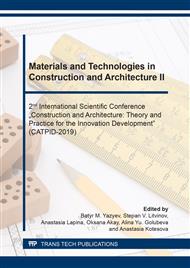[1]
Y.V. Denisova, Additive technology in construction, Construction Materials and Products. 1(3) (2018) 33-42.
Google Scholar
[2]
V. Promakhov, A. Zhukov, I. Dubkova, I. Zhukov, S. Kovalchuk, T. Zhukova, A. Olisov, V. Klimenko, N. Savkina, Structure and Properties of ZrO2-20%Al2O3 Ceramic Composites Obtained Using Additive Technologies, Materials. 11 (12) (2018) 2361.
DOI: 10.3390/ma11122361
Google Scholar
[3]
M.Y. Elistratkin, V.S. Lesovik, N.I. Alfimova, I.M. Shurakov, On the question of mix composition selection for construction 3D printing, Materials Science Forum, 945, (2019). 218-225.
DOI: 10.4028/www.scientific.net/msf.945.218
Google Scholar
[4]
M.Yu. Elistratkin, V.S. Lesovik, N.I. Alfimova, E.S. Glagolev, About developing of the building press technologies, Bulletin of BSTU named after V.G. Shukhov. 5 (2018) 11–19. (In Russian).
DOI: 10.12737/article_5af5a727274397.04099320
Google Scholar
[5]
Information on https://www.createdigital.org.au/3d-printing-house-cut-time-cost-waste/.
Google Scholar
[6]
G. De Schutter, K. Lesage, V. Mechtcherine, V. Naidu Nerella, G. Habert, I. Agusti-Juan, Vision of 3D printing with concrete – Technical, economic and environmental potentials, Cement and Concrete Research. 112 (2018) 25-36.
DOI: 10.1016/j.cemconres.2018.06.001
Google Scholar
[7]
N. Roussel, Rheological requirements for printable concretes, Cement and Concrete Research. 112 (2018) 76-85.
DOI: 10.1016/j.cemconres.2018.04.005
Google Scholar
[8]
V.A. Poluektova, N.A. Shapovalov, R.O. Chernikov and E.I. Evtushenko, Patent RU 2661970. (2018).
Google Scholar
[9]
Information on http://www.newchemistry.ru/printletter.php?n_id=2971.
Google Scholar
[10]
Information on http://melnicabiz.ru/business_publikacii/30_biznes-proizvodstvo-suhih-stroitelnih-smesei-mini-zavod.html.
Google Scholar
[11]
S.A. Starchenko, V.A. Polyektova, The research of the drying process of the superplasticizing agent on the basis of phloroglucine-furfural oligomers, International scientific and technical conference of young scientists of V.G. Shukhov Belgorod State Technical University (2018) 1-4.
Google Scholar
[12]
Maevsky S.M., Relative credibility - objective evaluation of quality control, Technical diagnostics and non-destructive testing. 2 (2010) 24-27.
Google Scholar
[13]
Braginskaya T.A., Control and testing as forms of product quality testing, Bulletin of Volga State Academy of Water Transport. 43 (2015) 69-75.
Google Scholar
[14]
N. Vatin, L. Chumadova, I. Goncharov, V. Zykova, A. Karpenya, A. Kim and E. Finashenkov, 3D printing in construction, Construction of Unique Buildings and Structures. 1(52) (2017) 27-46.
Google Scholar
[15]
F. Bos, R. Wolfs, Z. Ahmed, T. Salet, Additive manufacturing of concrete in construction: potentials and challenges of 3D concrete printing, Virtual Phys. Prototyp. 11 (2016) 209-225.
DOI: 10.1080/17452759.2016.1209867
Google Scholar
[16]
B. Panda, S.C. Paul, L.J. Hui, Y.W.D. Tay, M.J. Tan, Additive manufacturing of geopolymer for sustainable built environment, J. Clean. Prod. 167 (2017) 281-288.
DOI: 10.1016/j.jclepro.2017.08.165
Google Scholar
[17]
R.A. Buswell, W.R. Leal de Silva, S.Z. Jones, J. Dirrenberger, Cement and Concrete Research. 112 (2018) 37-49.
DOI: 10.1016/j.cemconres.2018.05.006
Google Scholar
[18]
T. Le, S. Austin, S. Lim, R. Buswell, R. Law, A. Gibb, T. Thorpe, Hardened properties of high-performance printing concrete, Cem. Concr. Res. 42 (2012) 558-566.
DOI: 10.1016/j.cemconres.2011.12.003
Google Scholar
[19]
C. Gosselin, R. Duballet, P. Roux, N. Gaudillière, J. Dirrenberger, P. Morel, Large-scale 3D printing of ultra-high performance concrete - a new processing route for architects and builders, Mater. Des. 100 (2016) 102-109.
DOI: 10.1016/j.matdes.2016.03.097
Google Scholar
[20]
O. Godbold, R. Soar, R. Buswell, Implications of solid freeform fabrication on acoustic absorbers, Rapid Prototyp. J. 13 (2007) 298-303.
DOI: 10.1108/13552540710824805
Google Scholar
[21]
O. Godbold, J. Kang, R. Buswell, R. Soar, Fabrication of acoustic absorbing topologies using rapid prototyping, Can. Acoust. 36 (2008) 144-145.
Google Scholar
[22]
B. Panda, S.C. Paul, N.A.N. Mohamed, Y.W.D. Tay, M.J. Tan, Measurement of tensile bond strength of 3D printed geopolymer mortar, Measurement. 113 (2018) 108-116.
DOI: 10.1016/j.measurement.2017.08.051
Google Scholar
[23]
A.Bentur, Properties of polymer latex-cement composites, International Journal of Cement Composites and Lightweight Concrete. 4 (1982) 57-65.
DOI: 10.1016/0262-5075(82)90008-2
Google Scholar
[24]
A. FJ, Fracture model for flexural failure of beams retrofitted with CARDIFRC, Journal of Engineering Mechanics. 129 (2003) 1028-1030.
DOI: 10.1061/(asce)0733-9399(2003)129:9(1028)
Google Scholar
[25]
R.N. Swamy, A.M.A.H. Ali, Assessment of in situ concrete strenght by various non-destructive tests, NDT International. 17 (1984) 139-146.
DOI: 10.1016/0308-9126(84)90002-6
Google Scholar


